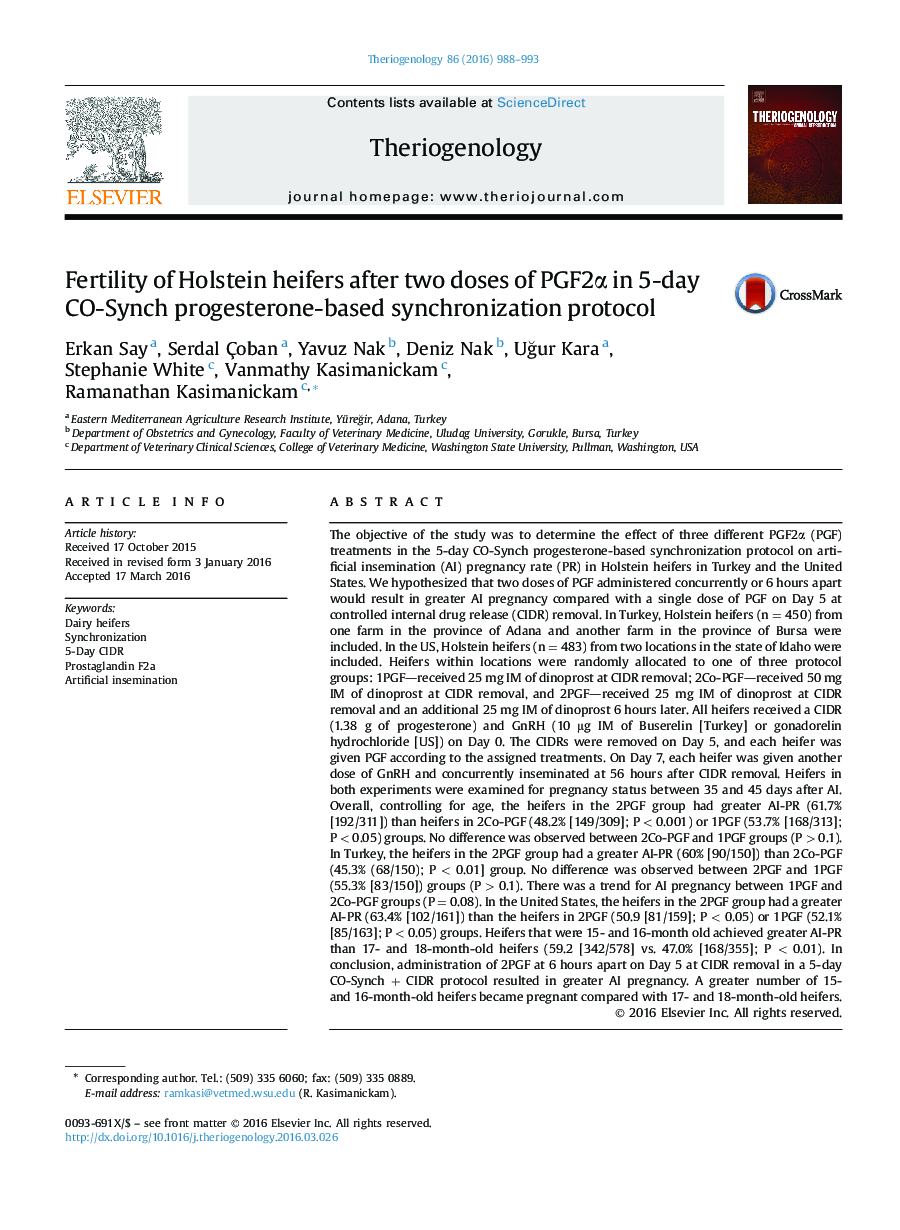| کد مقاله | کد نشریه | سال انتشار | مقاله انگلیسی | نسخه تمام متن |
|---|---|---|---|---|
| 2094720 | 1082049 | 2016 | 6 صفحه PDF | دانلود رایگان |
The objective of the study was to determine the effect of three different PGF2α (PGF) treatments in the 5-day CO-Synch progesterone-based synchronization protocol on artificial insemination (AI) pregnancy rate (PR) in Holstein heifers in Turkey and the United States. We hypothesized that two doses of PGF administered concurrently or 6 hours apart would result in greater AI pregnancy compared with a single dose of PGF on Day 5 at controlled internal drug release (CIDR) removal. In Turkey, Holstein heifers (n = 450) from one farm in the province of Adana and another farm in the province of Bursa were included. In the US, Holstein heifers (n = 483) from two locations in the state of Idaho were included. Heifers within locations were randomly allocated to one of three protocol groups: 1PGF—received 25 mg IM of dinoprost at CIDR removal; 2Co-PGF—received 50 mg IM of dinoprost at CIDR removal, and 2PGF—received 25 mg IM of dinoprost at CIDR removal and an additional 25 mg IM of dinoprost 6 hours later. All heifers received a CIDR (1.38 g of progesterone) and GnRH (10 μg IM of Buserelin [Turkey] or gonadorelin hydrochloride [US]) on Day 0. The CIDRs were removed on Day 5, and each heifer was given PGF according to the assigned treatments. On Day 7, each heifer was given another dose of GnRH and concurrently inseminated at 56 hours after CIDR removal. Heifers in both experiments were examined for pregnancy status between 35 and 45 days after AI. Overall, controlling for age, the heifers in the 2PGF group had greater AI-PR (61.7% [192/311]) than heifers in 2Co-PGF (48.2% [149/309]; P < 0.001) or 1PGF (53.7% [168/313]; P < 0.05) groups. No difference was observed between 2Co-PGF and 1PGF groups (P > 0.1). In Turkey, the heifers in the 2PGF group had a greater AI-PR (60% [90/150]) than 2Co-PGF (45.3% (68/150); P < 0.01] group. No difference was observed between 2PGF and 1PGF (55.3% [83/150]) groups (P > 0.1). There was a trend for AI pregnancy between 1PGF and 2Co-PGF groups (P = 0.08). In the United States, the heifers in the 2PGF group had a greater AI-PR (63.4% [102/161]) than the heifers in 2PGF (50.9 [81/159]; P < 0.05) or 1PGF (52.1% [85/163]; P < 0.05) groups. Heifers that were 15- and 16-month old achieved greater AI-PR than 17- and 18-month-old heifers (59.2 [342/578] vs. 47.0% [168/355]; P < 0.01). In conclusion, administration of 2PGF at 6 hours apart on Day 5 at CIDR removal in a 5-day CO-Synch + CIDR protocol resulted in greater AI pregnancy. A greater number of 15- and 16-month-old heifers became pregnant compared with 17- and 18-month-old heifers.
Journal: Theriogenology - Volume 86, Issue 4, 1 September 2016, Pages 988–993
